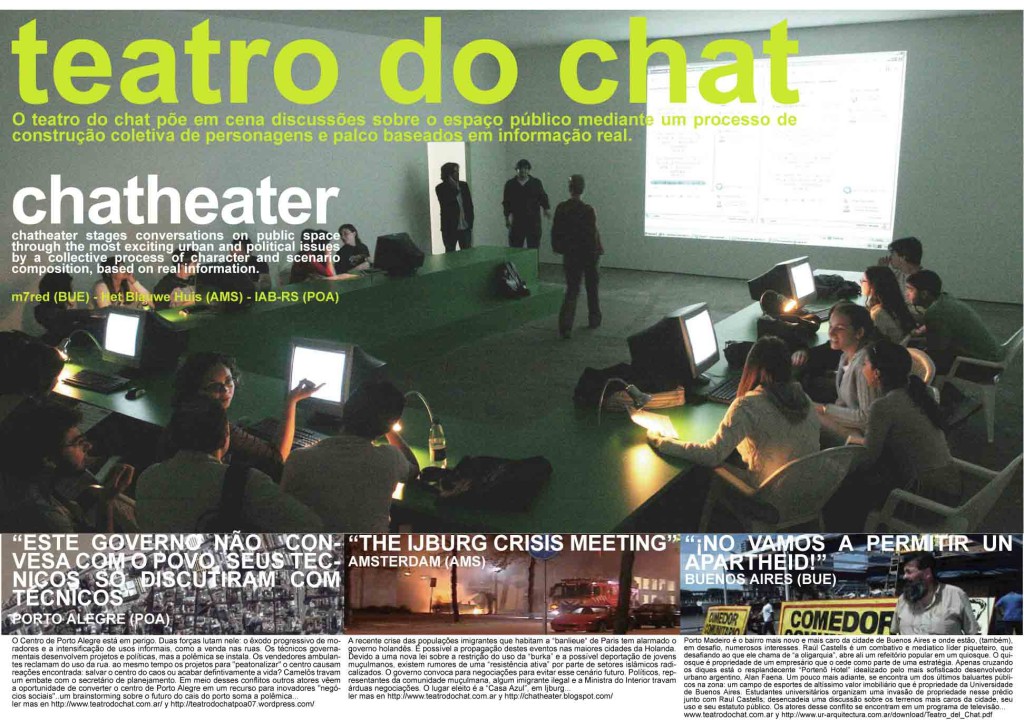How are cities populated? What conflicts unite and separate them?
Chatheater is a game created by m7red in order to promote political discussion about urban problems. It’s a roleplaying game in which, like in theater, participants act as protagonists of a conflict. This is a real and current urban conflict, and the process involves field work, collective workshops and discussions and public performances.
Chatheater can be utilized to broach any subject. The important thing is that it involves social actors with different positions regarding a topic, making the game participants assume different political postures to act in the chat discussion.
Entities, things, infrastructures, people, machines, groups, institutions, characters, how do they live with each other? How are cities populated? What conflicts unite and separate them?
Chatheater raises the problem of the city’s mise-en-scene, of the public staging of beings or entities and their coexistence. Making public this diversity is a political bet. Parliaments are a scenario where cities can see themselves, but parliaments are a particular type of staging of the public.
Chatheater posits the challenge of the collective construction of characters and urban scenarios as a new scenic-political device. It started in 2006 as an experiment of urban discussion that connected the cities of Amsterdam and Buenos Aires in a real time roleplaying game through the internet.
The stage built for Buenos Aires hypothesized a social class confrontation in Puerto Madero, the city’s most recent and expensive urbanization process. The one that emerged in Amsterdam staged the conflict between the local community and the muslim minority, as a continuation of the racial riots that took place in France during the year 2005.
In 2007 an eight month discussion process was set up in the city of Porto Alegre as part of the 6th Bienal do Mercosul. The scenario that emerged this time was the center of the city where the event took place: the occupation by informal occupation and habitational vacating. A hall for the representations was set up. The device consisted of some actoral training cabins for citizens, and a discussion hall through networked computers. From this experience, the Architects Institute of Brazil from Rio Grande do Sul commissioned the planification of a research program and the design of a hall of the Chatheater to explore the urban future of Porto Alegre.
The work with social scenarios and human characters, however, became insufficient to understand the growing complexity of an urbanization phenomenon. This became apparent at the beginning stages for the construction of a new scenario for the city of Buenos Aires: the one regarding the Riachuelo-Matanza River basin, that puts in the same scene human and non-human characters.
Credits:
- Hosted by Het Blauwe Huis, selected by Jeanne van Heeswijk and Herve Paraponaris. IJburg, Amsterdam, Netherlands, 2006-2009.
- Scenario created in partnership with the Architects of Brazil Institute, Rio Grande do Sul department (Instituto de Arquitetos do Brasil, departamento Rio Grande do Sul), Porto Alegre, Rio Grande do Sul, Brazil, 2007-2008.
- Workshop: “Imaginación urbana e información pública” (Urban imagination and public imagination) at the Bienal do Porto Alegre, Memorial do Rio Grande do Sul, Praça da Alfândega. Bairro Centro. Porto Alegre, Brazil, March 10th to 31st, 2007.
- Lecture at Jan van Eyck Academie, Maastricht, Netherlands, 2007.
- Workshop: “Teatro analítco/performático y planificación urbana” (Analytic/Performative theater and urban planning), at the Faculty of Architecture and Urbanism of the Federal University of Rio Grande do Sul, Rio Grande do Sul, Brazil, 2008.
- Supported by the Cultural Center of Spain in Buenos Aires (CCEBA), Buenos Aires, 2008-2009.


